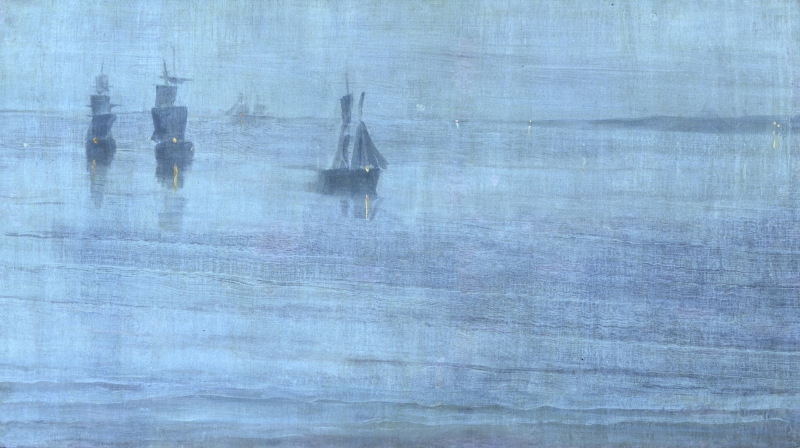Titles
Two titles have been suggested:
- ‘Nocturne, the Solent’ (1935, New York Times). 1
- ‘Nocturne, the Solent’ (1937, City Art Museum of St. Louis). 2
- ‘Nocturne en bleu et argent’ (1937, Bulletin of the City Museum of St. Louis. 3
- ‘Nocturne; The Solent’ (1947, Macbeth Gallery). 4
- ‘On the Solent’ (1949, Lyman Allyn Museum). 5
- ‘Nocturne: The Solent’ (1980, YMSM). 6
Whistler's original title is not known. The first title that definitely applies to this painting was published in 1935: ‘Nocturne, the Solent’. 7 It was suggested in the 1980 catalogue raisonné that the title 'Nocturne: The Solent' could have been derived from one of the ships, the Solent, on which Whistler travelled to Valparaiso in 1866. Whistler could have painted the Solent in the West Indies, or at Colon, or in one of the South American ports, or, indeed, back in Southampton. The Solent was built in 1857, to a new design, by J. & R. White of Cowes. She was a ship of 1804 tons built for the Royal West Indian Mail Company and could conceivably have been one of the ships in the picture.
However, it is now thought that the picture dates from 1870/1871. The site is therefore likely to be the waterway called the Solent, between Southampton and the Isle of Wight. 8 Whistler painted two other Nocturnes in that area (Nocturne: Blue and Gold - Southampton Water [YMSM 117] and Nocturne in Black and Gold: Entrance to Southampton Water [YMSM 179]). However, it remains unclear how the site was identified as the Solent in the 1930s, and if there were earlier records of its title, now lost. However, to avoid confusion, 'Nocturne: The Solent' has been retained until the original title can be established.
Description
A seascape in horizontal format, showing, at left, three sailing ships out at sea. There is a another ship on the horizon, and at far right, the faint indication of land. The sea is very calm.
The ships all appear to be sailing more or less towards the viewer, the foremost from left to right, the next from right to left, and the third directly towards the viewer but very slightly from right to left. The nearest ship is probably a small two-masted fore-and-aft schooner, although the configuration of the sails is confusing. The second is a two-masted, square-rigged brig, probably a small merchant ship. The third ship, sailing towards the viewer, is again a small two-masted, square-rigged brig. Whistler may have used artistic license in depicting the lights, both in colour and position. 9
Site
There has been some confusion about whether this painting represents a ship called the Solent en route to Valparaiso, or the strait between the Isle of Wight and the mainland at Southampton, of that name.
It is now thought most likely that it was painted on the Solent near Southampton in the early 1870s. Two other Nocturnes were painted there, namely Nocturne: Blue and Gold - Southampton Water [YMSM 117] and Nocturne in Black and Gold: Entrance to Southampton Water [YMSM 179].
Comments
The early history is uncertain, but it was immediately accepted as an authentic Whistler painting by both Joseph Pennell (1860-1926) and Théodore Duret (1838-1927). 10
Notes:
1: New York Times, 16 October 1935 [more] .
2: Bulletin of the St Louis Art Museum 1937[more] , p. 44.
3: Bulletin of the St Louis Art Museum 1937[more] , at p. 44.
4: Exhibition catalogue New York 1947 [more] (cat. no. 4).
5: Exhibition catalogue New London 1949 [more] (cat. no. 32).
6: YMSM 1980 [more] (cat. no. 71).
7: New York Times, New York, 16 November 1935, p. 13, op. cit.
8: Getscher 2004 [more] , pp. 13-14.
9: Many thanks to Iain P. MacInnes, naval architect and historian, for this information.
10: Copies of letters from Pennell and Duret, 1910, Whistler Paintings Project files, Glasgow University Library.
Last updated: 2nd December 2020 by Margaret






